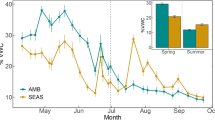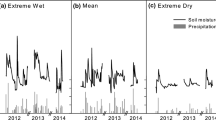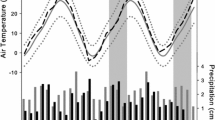Abstract
For the southwestern United States, climate models project an increase in extreme precipitation events and prolonged dry periods. While most studies emphasize plant functional type response to precipitation variability, it is also important to understand the physiological characteristics of dominant plant species that define plant community composition and, in part, regulate ecosystem response to climate change. We utilized rainout shelters to alter the magnitude and frequency of rainfall and measured the physiological response of the dominant C4 grasses, Bouteloua eriopoda and Bouteloua gracilis. We hypothesized that: (1) the more drought-adapted B. eriopoda would exhibit faster recovery and higher rates of leaf-level photosynthesis (A net) than B. gracilis, (2) A net would be greater under the higher average soil water content in plots receiving 30-mm rainfall events, (3) co-dominance of B. eriopoda and B. gracilis in the ecotone would lead to intra-specific differences from the performance of each species at the site where it was dominant. Throughout the study, soil moisture explained 40–70 % of the variation in A net. Consequently, differences in rainfall treatments were not evident from intra-specific physiological function without sufficient divergence in soil moisture. Under low frequency, larger rainfall events B. gracilis exhibited improved water status and longer periods of C gain than B. eriopoda. Results from this study indicate that less frequent and larger rainfall events could provide a competitive advantage to B. gracilis and influence species composition across this arid–semiarid grassland ecotone.





Similar content being viewed by others
References
Allred KW (2005) A field guide to the grasses of New Mexico. Agricultural Experiment Station, New Mexico State University, Las Cruces
Ares J (1976) Dynamics of the root system of blue grama. J Range Manage 29:208–213
Augilera MO, Lauenroth WK (1993) Neighborhood interactions in a natural population of the perennial bunchgrass Bouteloua gracilis. Oecologia 94:595–602
Augustine DJ, Derner JD, Milchunas DG (2010) Prescribed fire, grazing, and herbaceous plant production in shortgrass steppe. Range Ecol Manage 63:317–323
Báez S, Collins SL, Pockman WT, Johnson JE, Small EE (2013) Effects of experimental rainfall manipulations on Chihuahuan Desert grassland and shrubland plant communities. Oecologia 172:1117–1127
Bestelmeyer BT, Ward JP, Havstad KM (2006) Soil-geomorphic heterogeneity governs patchy vegetation dynamics at an arid ecotone. Ecology 87:963–973
Buxbaum CAZ, Vanderbilt K (2007) Soil heterogeneity and the distribution of desert and steppe plant species across a desert-grassland ecotone. J Arid Environ 69:617–632
Casper BB, Jackson RB (1997) Plant competition underground. Annu Rev Ecol Syst 28:545–570
Collins SL, Xia Y (2015) Hotspots and dynamic boundaries: long-term vegetation change in a desert grassland plant community. Am Nat (in press)
Dodd MB, Lauenroth WK, Welker JM (1998) Differential water resource use by herbaceous and woody plant life-forms in a shortgrass steppe community. Oecologia 117:504–512
English NB, Weltzin JF, Fravolini A, Thomas L, Williams DG (2005) The influence of soil texture and vegetation on soil moisture under rainout shelters in a semi-desert grassland. J Arid Environ 63:324–343
Fernández RJ, Reynolds JF (2000) Potential growth and drought tolerance of eight desert grasses: lack of trade-off? Oecologia 123:90–98
Fernández RJ, Wang M, Reynolds JF (2002) Do morphological changes mediate plant responses to water stress? A steady-state experiment with two C4 grasses. New Phytol 155:79–88
Fowler NL (1986) The role of competition in plant communities in arid and semi-arid regions. Annu Rev Ecol Syst 17:89–110
Gibbens RP, Lenz JM (2001) Root systems of some Chihuahuan Desert plants. J Arid Environ 49:221–263
Goldberg D, Novoplansky A (1997) On the relative importance of competition in unproductive environments. J Ecol 85:409–418
Gosz JR (1993) Ecotone hierarchies. Ecol Appl 3:369–376
Gosz JR, Sharpe PJH (1989) Broad-scale concepts for interactions of climate, topography, and biota at biome transitions. Landsc Ecol 3:229–243
Hamerlynck EP, McAuliffe JR, McDonald EV, Smith SD (2002) Ecological responses of two Mojave Desert shrubs to soil horizon development and soil water dynamics. Ecology 83:768–779
Hamerlynck EP, Scott RL, Moran MS, Keefer TO, Huxman TE (2010) Growing season ecosystem and leaf-level gas exchange of an exotic and native semiarid bunchgrass. Oecologia 163:561–570
Hamerlynck EP, Scott RL, Moran MS, Schwander AM, Connor E, Huxman TE (2011) Inter- and under-canopy soil water, leaf-level and whole-plant gas exchange dynamics of a semi-arid perennial C4 grass. Oecologia 165:17–29
Heisler-White JL, Knapp AK, Kelly EF (2008) Increasing precipitation event size increases aboveground net primary productivity in a semi-arid grassland. Oecologia 158:129–140
Hochstrasser T, Kröel-Dulay G, Peters DPC, Gosz JR (2002) Vegetation and climate characteristics of arid and semi-arid grasslands in North America and their biome transition zone. J Arid Environ 51:55–78
Hooper DU, Johnson L (1999) Nitrogen limitation in dryland ecosystems: responses to geographical and temporal variation in precipitation. Biogeochemistry 46:247–293
Huxman TE, Cable JM, Ignace DD, Eilts JA, English NB, Weltzin J, Williams DG (2004) Response of net ecosystem gas exchange to a simulated precipitation pulse in a semi-arid grassland: the role of native versus non-native grasses and soil texture. Oecologia 141:295–305
Ignace DD, Huxman TE, Weltzin JF, Williams DG (2007) Leaf gas exchange and water status responses of a native and non-native grass to precipitation across contrasting soil surfaces in the Sonoran Desert. Oecologia 152:401–413
Intergovernmental Panel on Climate Change (IPCC) (2013) Climate change 2013: the physical science basis. Summary for policymakers. Cambridge University Press, New York
Ladwig LM, Collins SL, Swann AL, Xia Y, Allen MF, Allen EB (2012) Above- and belowground responses to nitrogen addition in a Chihuahuan Desert grassland. Oecologia 169:177–185
Langley JA, Megonigal JP (2010) Ecosystem response to elevated CO2 levels limited by nitrogen-induced plant species shift. Nature 466:96–99
Lauenroth WK, Sala OE (1992) Long-term forage production of North American shortgrass steppe. Ecol Appl 2:397–403
Lauenroth WK, Sala OE, Milchunas DG, Lathrop RW (1987) Root dynamics of Bouteloua gracilis during short-term recovery from drought. Funct Ecol 1:117–124
Lauenroth WK, Burke IC, Morgan JA (2008) The shortgrass steppe: the region and research sites. In: Lauenroth WK, Burke IC (eds) Ecology of the shortgrass steppe. Oxford University Press, New York, pp 3–13
Lee CA, Lauenroth WK (1994) Spatial distributions of grass and shrub root systems in the shortgrass steppe. Am Midl Nat 132:117–123
Loik ME, Breshears DD, Lauenroth WK, Belnap J (2004) A multi-scale perspective of water pulses in dryland ecosystems: climatology and ecohydrology of the western USA. Oecologia 141:269–281
McCulley RL, Jobbagy EG, Pockman WT, Jackson RB (2004) Nutrient uptake as a contributing explanation for deep rooting in arid and semiarid ecosystems. Oecologia 141:620–628
Milchunas DG, Lauenroth WK (1995) Inertia in plant community structure: state changes after cessation of nutrient enrichment stress. Ecol Appl 5:452–458
Minnick TJ, Coffin DP (1999) Geographic patterns of simulated establishment of two Bouteloua species: implications for distributions of dominants and ecotones. J Veg Sci 10:343–356
Monger HC, Bestelmeyer BT (2005) The soil-geomorphic template and biotic change in arid and semi-arid ecosystems. J Arid Environ 65:207–218
Muldavin EH, Moore DI, Collins SL, Wetherill KR, Lightfoot DC (2008) Aboveground net production dynamics in a northern Chihuahuan Desert ecosystem. Oecologia 155:123–132
Neilson RP (1986) High-resolution climatic analysis and Southwest biogeography. Science 232:27–34
Neilson RP (1993) Transient ecotone response to climatic change: some conceptual and modeling approaches. Ecol Appl 3:385–395
Noy-Meir I (1973) Desert ecosystems: environment and procedures. Annu Rev Ecol Syst 4:25–52
Parmenter RR (2008) Long-term effects of a summer fire on desert grassland plant demographics in New Mexico. Range Ecol Manage 61:156–168
Patrick LD, Ogle K, Bell CW, Zak J, Tissue D (2009) Physiological response of two contrasting desert plant species to precipitation variability are differentially regulated by soil moisture and nitrogen dynamics. Glob Change Biol 15:1214–1229
Peters DPC (2002) Recruitment potential of two perennial grasses with different growth forms at a semiarid-arid transition zone. Am J Bot 89:1616–1623
Peters DC, Yao J (2012) Long-term experimental loss of foundation species: consequences for dynamics at ecotones across heterogeneous landscapes. Ecosphere 3:27–50
Peters DPC, Gosz JR, Pockman WT, Small EE, Parmenter RR, Collins SL, Muldavin E (2006a) Integrating patch and boundary dynamics to understand and predict biotic transitions at multiple scales. Landsc Ecol 21:19–33
Peters DPC, Yao J, Gosz JR (2006b) Woody plant invasion at a semi-arid/arid transition zone: importance of ecosystem type to colonization and patch expansion. J Veg Sci 17:389–396
Pockman WT, Small EE (2010) The influence of spatial patterns of soil moisture on the grass and shrub responses to a summer rainstorm in a Chihuahuan Desert ecotone. Ecosystems 13:511–525
Reynolds JF, Kemp PR, Ogle K, Fernández RJ (2004) Modifying the ‘pulse-reserve’ paradigm for deserts of North America: precipitation pulses, soil water, and plant responses. Oecologia 141:194–210
Risser PG (1995) The status of the science examining ecotones. Bioscience 45:318–325
Robertson TR, Bell CW, Zak JC, Tissue DT (2009) Precipitation timing and magnitude differentially affect aboveground annual net primary productivity in three perennial species in a Chihuahuan Desert grassland. New Phytol 181:230–242
Sala OE, Lauenroth WK (1982) Small rainfall events: an ecological role in semi-arid regions. Oecologia 53:301–304
Sala OE, Parton WJ, Joyce LA, Lauenroth WK (1988) Primary production of the central grassland region of the United States. Ecology 69:40–45
Sala OE, Lauenroth WK, Parton WJ (1992) Long term soil water dynamics of the shortgrass steppe. Ecology 73:1175–1181
Seager R, Vecchi GA (2010) Greenhouse warming and the 21st century hydroclimate of southwestern North America. Proc Natl Acad Sci USA 107:21277–21282
Senock RS, Devine DL, Sisson WB, Donart GB (1994) Ecophysiology of three C4 perennial grasses in the northern Chihuahuan Desert. Southwest Nat 39:122–127
Thomey ML, Collins SL, Vargas R, Johnson JE, Brown RF, Natvig DO, Friggens MT (2011) Effect of precipitation variability on net primary production and soil respiration in a Chihuahuan Desert grassland. Glob Change Biol 17:1505–1515
Yanoff S, Muldavin E (2008) Grassland-shrubland transformation and grazing: a century-scale view of a northern Chihuahuan Desert grassland. J Arid Environ 72:1594–1605
Acknowledgments
Special thanks to Lily Shuster, Sevilleta Long-Term Ecological Research (LTER) staff and summer interns, Rob Pangle, Judd Hill, and the SNWR. This research was supported by the US Department of Energy’s Office of Science (Biological and Environmental Research) through the Western Regional Center of the National Institute for Climatic Change Research, and the National Science Foundation grant to the University of New Mexico for LTER (DEB no. 0832652). Funding for M. L. T. was provided by the Sevilleta LTER summer fellowship, T&E, University fo New Mexico (UNM) Department of Biology Alumni Scholarships, UNM GRAC, SRAC, RPT.
Author information
Authors and Affiliations
Corresponding author
Additional information
Communicated by Joy K. Ward.
Electronic supplementary material
Below is the link to the electronic supplementary material.
Rights and permissions
About this article
Cite this article
Thomey, M.L., Collins, S.L., Friggens, M.T. et al. Effects of monsoon precipitation variability on the physiological response of two dominant C4 grasses across a semiarid ecotone. Oecologia 176, 751–762 (2014). https://doi.org/10.1007/s00442-014-3052-1
Received:
Accepted:
Published:
Issue Date:
DOI: https://doi.org/10.1007/s00442-014-3052-1




